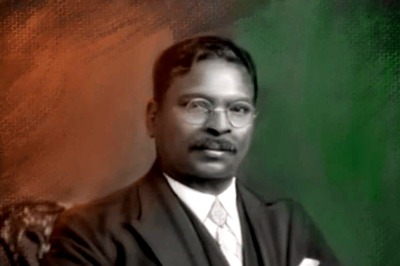
views
When Austrian Gustav Baldauf, a former pilot with 14,000 hours of flying experience, took over as chief operating officer at Air India in the troubled times of 2008, many thought it was the turning point that the beleaguered airline had been waiting for. Its day-to-day operations needed as much fixing as its mounting debt and loss of market share did.
Yet, on February 28, when Baldauf resigned from the company, it looked like the cause had been lost. Operations were as muddled as before: The merger of Air India and Indian Airlines was still on paper with the two wings operating pretty much independently; there was a strike notice from the staff union; debt had mounted to Rs. 15,000 crore; two more senior officials — Pawan Arora, COO of Air India Express and Stephen Sukumar, chief training officer — had also quit.
And, at least to casual observers, it looked like the new civil aviation minister, Vayalar Ravi, had taken things in his own hands, undermining the nascent turnaround strategy that was being put in place. A career trade unionist who had been in the labour movement for nearly 60 years, Ravi sent shivers down the collective spine of pro-reform forces. It was a reasonable question to ask if Air India was slipping out of the control of the business-side guys such as Chairman and Managing Director Arvind Jadhav.
It turns out that reality is quite different. Baldauf may not exactly have been the face of reform that was defeated by status quoists. Instead, he alienated himself from the agenda by missing the cultural nuances of a giant public sector company and the bureaucratic compulsions that come with it.
Perhaps, he handled Air India like a private company, which it isn’t. “Captain Baldauf made dozens of presentations on what needed to be done. Unfortunately he was unable to execute any of it,’’ says a senior executive who had worked closely with him. The COO’s biggest failure was the inability to realise that even though the merger was complete on paper, employees were still operating under two entirely different conditions. Below the general manager level (98 percent of the workforce), they were actually two different airlines, Nacil A and Nacil I. He came at the problem assuming he was dealing with one. The pitch, roll and yaw — Captain Baldauf lost control of all.
On the contrary, Vayalar Ravi seems to be taking a pragmatic approach. Being the seasoned negotiator that he is, Ravi is working towards a solution that will be binding on all parties — the unions, the management and the government. He is able to appreciate the complexities of integrating two separate staff forces, with different pay scales and service rules. Through his goodwill with the unions, if he is able to push through a wage cut and tougher productivity-linked compensation, he will have achieved where others failed.
On his part, CMD Jadhav has gone on an overdrive to fix the business model. He is making fundamental changes to how the airline is run, boosting its international profile and revving up plans to use the spanking new aircraft fleet better. If Ravi’s human touch succeeds, Jadhav’s business excellence can put a unified Air India back in the game again. Lets face it, government ownership means that Air India can never be like a privately-owned airline, but it does have the advantage of a huge infrastructure and extensive network. If it is put back on the recovery track, it could even be privatised some day. The high-profile exits would then be just a distant memory, not a crippling damage as some would fear.
Yielding Place to Old
By the time Baldauf put in his papers on Budget Day, those around him knew that he was pretty much done with Air India. The unions and some employees didn’t approve of him because he was an ‘outsider’ being paid Rs. 3 crore, while their salaries were delayed on most months. Even senior officials, including board members, came to think that he was unable to make it work.
CMD Jadhav, the man who had pushed for new blood in the system says Baldauf and others (brought into the airline last year) had been unable to understand the complexity. “In a merger or acquisition, there is usually one strong partner who is able to call the shots. In this case, both are strong PSUs, who think their strategy is [the] best,’’ he says. Captain Baldauf declined to speak to Forbes India for this story.
Vayalar Ravi is anything but new blood. The 73-year-old who entered Parliament four decades ago is a staunch socialist committed to protecting every job in government companies. As soon as he became the civil aviation minister in the latest reshuffle of Prime Minister Manmohan Singh’s ministry, Ravi opened up communication lines with the unions of the national carrier. From morning to evening, Ravi spent nine hours a day for three days hearing out the labour. “He speaks our language,” says George Abraham, general secretary of the Air India Employees Guild, the airline’s largest union.
The unions told him why the two airlines couldn’t merge at the operational level. Their pay scales, their career graph, the rules were all different and nobody had yet figured out one system that would satisfy both sides. Ravi suggested the appointment of a committee headed by a retired Supreme Court judge that will script a single parity structure for the entire workforce. But he didn’t let off the unions lightly. He extracted a commitment that they would abide by the committee award, come what may. “We have promised that we will ruthlessly abide with the award,’’ says Abraham. Knowing how strong the Air India unions are, this is nothing less than a coup.
Course Correction
Jadhav must be relieved that the minister is taking care of union sensibilities. This has left him free to take a hard look at the business model of Air India. Surely, it needs a lot of fixing. Jadhav has begun with three major shifts. They have not yet been noticed by the travelling public but they could change the Air India experience irrevocably and for the better.
First, after 70 years of operating as a point-to-point carrier, Air India is aligning its operations to be a ‘hub-and-spoke’ network airline. It has in the past tried to operate a hub system from Mumbai, and more recently from Frankfurt, but was never able to align operations because Indian Airlines was a separate carrier marching to its own beat. “Both airlines were competing neck and neck, on routes to the Gulf and Southeast Asia; any efforts at acting in concert did not work,’’ says a former Indian Airlines managing director.
A look at the Air India schedule shows that this is no longer the case. Terminal 3 at the New Delhi international airport is the new hub that connects to 43 Indian airports and 28 international stations. Domestic flights are being timed to arrive into Delhi in ‘banks’ — airline parlance for waves of arrivals and departures — three hours before the long haul international departures. Load factors on the flights have picked up immediately, resulting in higher profits per flight.
This has led to elimination of some unviable flights, especially on those linking a smaller Indian city with a first stop abroad. “Flights like Amritsar-London-Toronto were never more than half full because the rest of the country simply didn’t connect with Amritsar,’’ says Madhav Oza who has been selling Air India tickets for several years. They have been replaced by flights originating from Delhi, but by feeding in passengers from the rest of the country. At the heart of it is an Integrated Operations Control Centre (IOCC) at Delhi’s T3. Officers from flight operations, maintenance, flight dispatch, load control and commercial departments run it. The IOCC co-ordinates vital parametrs in the airline and is currently headed by Rod Butchers, a consultant from the International Air Transport Association (IATA).
The second big push towards improved revenues will be Air India’s entry into the Star Alliance, expected this July. The last hurdle for the entry was information technology integration and a common code, which was completed in February with the introduction of SITA’s passenger service system. This IT backbone, which cost the airline $190 million will provide Air India an online booking engine, departure control system, check-in and automated boarding control, baggage reconciliation system and a frequent flyer programme. Critics say this should have been done long ago. (Even at Star Alliance, a grouping of 27 global carriers, there has been a souring of relations as they waited for almost four years so that Air India could get its system in place.)
Jadhav, continues to be bullish about the future. He says the entry into the alliance will increase revenues by at least 12 to 15 percent. This is largely from passengers of other Star Alliance members who can use the AI network in this part of the world. They will be able to earn and burn their miles on the network. Suvojoy Sengupta, partner at Booz and Company, says changes like a unified code for both airlines can make a big difference. But they need to be pushed through quicker to be effective. One key event that marked how rapidly the airline was failing, he says, is when low cost carrier Indigo notched up a higher market share than Air India in November last year. To keep the systems unchanged and expect anyone to perform magic is unfair, he says.
The third change that will make a mark, albeit over the next few years, is the new equipment. Boeing will start delivering the 787 Dreamliner later this year, making Air India among the first few airlines in the world to get the machine that promises to shave off at least 15 percent from operating costs. The plane was supposed to be inducted as early as 2008, but has been delayed by production problems at Boeing. With the 787, we will have ‘horses for courses’, says Jadhav. The airline uses A310s, a much more expensive aircraft to operate and maintain, compared to the 787. “Delays in the 787 induction have cost Air India over $1.5 billion in [potential] revenue,’’ he says.
Outlining plans to expand Air India’s area of influence, Jadhav says the next step is to use the network to draw in passengers who currently fly over India, on other airlines. This means drawing passengers from countries like China, Thailand and Nepal traveling to Europe and the United States, into India. “They can connect on our non-stop flights to Toronto and New York from Delhi. The plan is to connect to expand the network to Australia and other destinations, with the new machines,” he says.
There is, however, one problem that Jadhav has yet to get a full grip on — the huge debts that need restructuring. Air India has the example of Kingfisher Airlines to emulate. Beer baron Vijay Mallya has been able to successfully restructure Kingfisher’s debt of close to Rs. 6,000 crore, giving it headroom to fly out of trouble. With a little help from the government, Air India hopes to do the same. The people problem, on the other hand, is an ultra-long haul fight. Who better to steer it than the labour-savvy Vayalar Ravi?




















Comments
0 comment